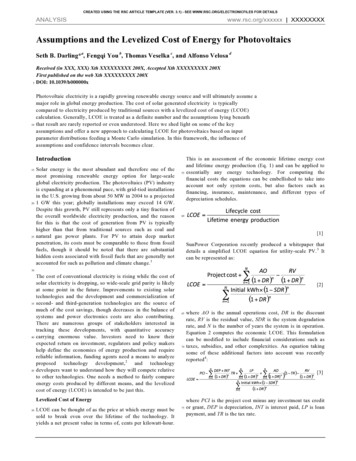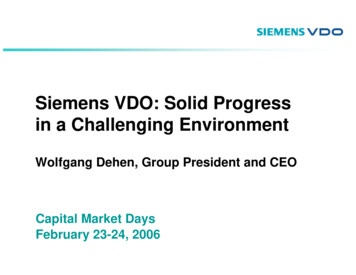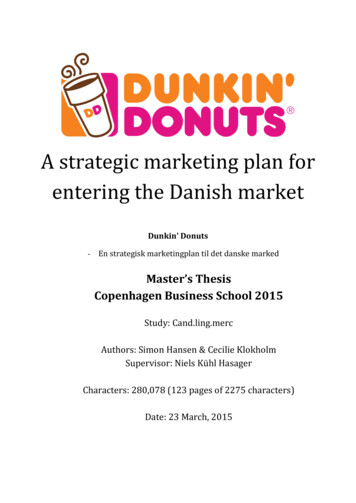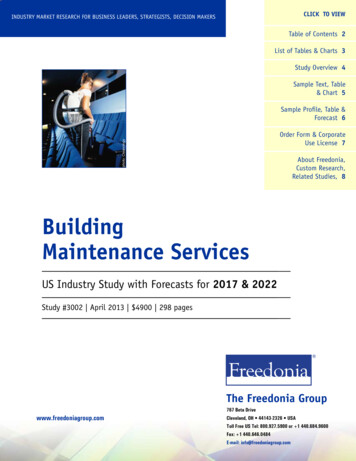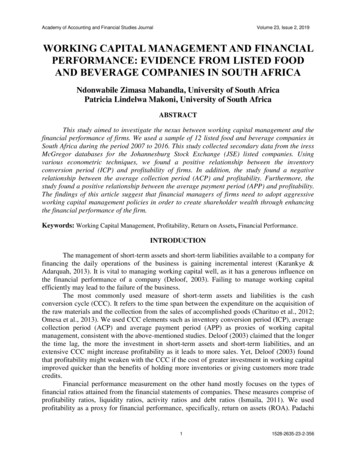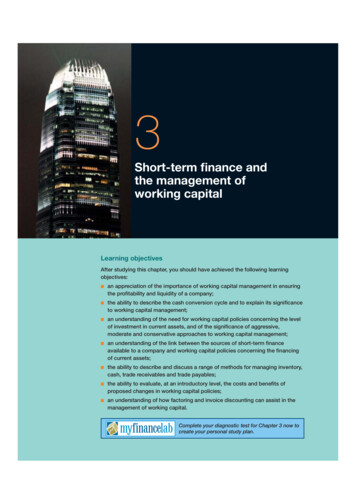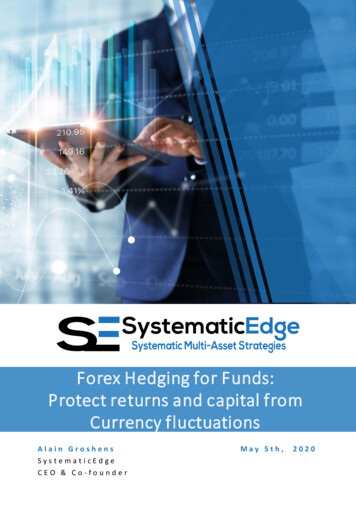
Transcription
Capital Market Assumptionsand Strategic Asset AllocationModelsMorningstar Investment Management EuropeAugust 2015
Section I – Executive SummaryThis document outlines the methodology used by Morningstar Investment Management Europe to build capitalmarket assumptions and strategic asset allocation models. This methodology leverages the extensive proprietaryresearch conducted by Morningstar entities across four decades, including Ibbotson Associates, a Morningstarcompany.The investment process can be summarised into a series of steps, each of which involves careful considerationand the application of various models and concepts that have been extensively researched and tested throughpractical implementation.Step 1: Capital Market Assumptions Identify opportunity set of asset classes’ Estimate long and Intermediate-term: Expected returns Standard deviations Skewness Kurtosis CorrelationsStep 2: Asset Allocation Optimisation: Mean-conditional value-at-risk Liability-relative Mean-variance Resampling1 Morningstar Investment Management Europe May 2015
Step 3: Investment Selection Scrutinise extensive database of availableinvestments Narrow universe through selection criteria Qualitative evaluation: Parent, People,Process, Performance, Price Quantitative evaluation: Representation ofasset classStep 4: Portfolio Construction Concentration risk: Manager, counterparty,strategy Diversification Tracking error management FlexibilityStep 5: Monitor Regular formal portfolio review Interim reviews led by market events Rebalancing Detailed performance attribution Custom benchmarkingPortfolio optimisation is an important tool that allows investors to identify a blend of assets that maximize returnfor a given level of risk or minimize risk for a given level of return. Optimisation requires forecasts of returns,standard deviations, skewness, kurtosis and correlation coefficients of asset classes over the desired investinghorizon.The Mean-Conditional Value at Risk optimisation process used within our methodology takes non-normal returncharacteristics into consideration, and in general, prefers assets with positive skewness, small kurtosis, and lowvariance.About Morningstar Investment ManagementDrawing on our core capabilities in asset allocation, manager research and portfolio construction, MorningstarInvestment Management Europe creates customised investment solutions to help financial institutions meetinvestor needs. We have both a global point of view and local market expertise, delivered through an internationalnetwork of experienced investment professionals who specialise in serving regional markets.When building investment offerings, we benefit from access to quality information from one of the largestinvestment databases, as well as patented methodologies, intuitive technologies and decades of ground breakingresearch. Our independence and strong investor focus allow us to develop solutions that help clients stand outwithin their markets. Our clients include many of the top wealth management firms, insurance companies, banks,asset managers, and retirement plan providers.Our investment processes incorporate the rich heritage of Ibbotson Associates, a leading independent assetallocation provider offering investment advisory services, retirement advice programs, and customized research.Ibbotson applies academic research to create real-world solutions for financial institutions. Ibbotson was foundedin 1977 and is a Morningstar company.2 Morningstar Investment Management Europe May 2015
Section II – Capital Market AssumptionsDefining the Investable UniverseAn often overlooked by investors, but important part of the process is the identification of the appropriate range ofasset classes available for inclusion within an investment solution or portfolio. The breadth and depth of theavailable securities ultimately provides the diversification benefits which a multi-asset solution in based on.A number of factors may dictate the approach taken to select the appropriate universe and to narrow this universeand focus on investment vehicles that best meet the objectives of the solution and ultimately the interests of theend investor. This may include: Domicile of investorsBase currency of investorAdditional information provided by our clients can be taken into consideration: Sophistication of investorsInvestor objectivesTechnical capabilities of product providerProprietary CMAsGlobal Capital Markets Sub-CommitteeMorningstar’s capital market assumptions are governed by the firm’s Global Capital Markets Sub-Committee. Thiscommittee, which is part of the investment management group’s Global Investment Policy Committee structure, iscomprised of senior investment professionals across our investment teams in North America, Europe and Asia. Itsresponsibilities include 1) the ongoing review the capital market assumptions and 2) developing new forecastingmethodologies to evolve institutional best practices.Inputs and EstimatesThe core methodology used by the majority of market participants to determine investment portfolios is meanvariance analysis. Mean-variance analysis was developed by Harry Markowitz in the 1950’s and provides amathematical framework for generating portfolios that maximize expected return for a given level of risk (efficientportfolios), and it can assist investors in making strategic asset allocation decisions.Mean-variance analysis requires three statistical estimates for each asset class: Expected return (Mean),Expected risk (Standard Deviation or Variance) and Expected relationship between the asset classes (CorrelationCoefficients).Morningstar recognises that asset class return distributions are not normally distributed and includesSkewness and Kurtosis as inputs to the asset allocation process.Morningstar, through its heritage in Ibbotson, is widely acknowledged as one of the leading authorities on thedevelopment of capital market expectations. Morningstar has written numerous award-winning articles on thesubject. Ibbotson’s “building block” methodology for estimating returns was first developed in the 1970s and wecontinue to improve upon it.3 Morningstar Investment Management Europe May 2015
Expected Return – EquityMorningstar uses a supply-side building blocks approach to forecast equity returns. First introduced by Diermeier,Ibbotson and Siegel (1984), and later adapted to stocks by Ibbotson and Chen (2003), the supply-side model isbased on the idea that equity returns can be decomposed into underlying economic and corporate fundamentals.Our approach separates the expected return of each equity asset class into four key drivers: 1) Inflation 2) TotalYield 3) Growth 4) Change in Valuation.Expected Return – Fixed IncomeSimilar to our equity asset class assumptions, Morningstar uses a building blocks approach to forecast returns offixed income asset classes. The key components of our fixed income model are: 1) Inflation 2) Real Rate 3) TermSpread and 4) Credit Spread. The expected shape of the yield curve also determines our forecast of the roll returnof a fixed-income asset class. Our model also takes into account the impact of rating upgrades and downgrades(credit migration) on credit bond prices.Expected Return – CurrenciesThe currency expected return is our forecast of the change in the spot exchange rate. In general, for any asset notdenominated in the reference currency, the expected return of the asset is based on the expected return in localcurrency plus the expected currency return. The currency expected return has two main components: 1) theinflation differential between the local currency and the reference currency, and 2) the reversion of real exchangerate to its fair value.Standard DeviationForecasting the range of possible outcomes requires the definition of dispersion (standard deviation) around anexpected value. Morningstar forecasts standard deviation as one aspect amongst various others that representrisk in an investment context.Morningstar employs a factor model approach to forecast standard deviation. The idea behind this estimationapproach is to model each benchmark as an optimal mix of long-history economic and market factors. A statisticalmodel is used to determine this mix.One of the advantages of this approach is that it directly addresses the basic problem of the incorporation ofinformation contained in long-history financial data into expectations for short-history benchmarks.Two main kinds of factors are used: Macroeconomic factors: exchange rates and inflation rates. Market factors: most are similar to those used by Fama and French in the sense that there is a broadmarket factor (total equity market total return for stocks, long government bond return for bonds) andthen the other factors are expressed as differences from the market factor.Skewness and KurtosisMean-CVaR analysis requires a quantifiable measure of Conditional Value at Risk (CVaR) for the resulting portfolio.To calculate this measure, Morningstar must provide estimates of Skewness and Kurtosis to more accuratelyrepresent the dispersion of expected monthly returns.Skewness measures the lack of symmetry in the distribution of returns. As an example, a positively skeweddistribution would have frequent small losses and a few extreme gains.Kurtosis measures the likelihood of extreme events.4 Morningstar Investment Management Europe May 2015
Correlation CoefficientThe risk of a portfolio is based not only on the risk of each asset class, but on the relationship between the returnsof asset classes as well. The relationship between the returns of asset classes is measured by the correlationcoefficient.The correlation coefficient measures the degree to which two asset classes’ returns change with respect to eachother. The statistic can range between positive one ( 1) and negative one (-1) and provides the followinginformation about the relationship between asset classes: Positive one ( 1): perfect positive relationship – two assets classes move together in the samedirection. No benefits arise from diversification.Negative one (–1): perfect negative relationship – two asset classes move together in oppositedirections, leading to maximum diversification benefits.Zero (0): no relationship – the movements of two asset classes are unrelated.Morningstar estimates correlation coefficients using the same factor model approach than for Standard Deviation.5 Morningstar Investment Management Europe May 2015
Section III – OptimisationOverviewWhen creating portfolios at the asset class level, Morningstar focuses on three major qualifications: (1) efficiencyand robustness, (2) investor preferences, and (3) investability. During the process asset classes are representedby carefully selected indices that represent a diversified proxy of the underlying securities. Portfolios that providethe best risk/return characteristics may not be practical or acceptable to many clients. Furthermore, the mostquantitatively efficient portfolios may not take into account possible errors in the input forecast, or the practicalitydue to liquidity constraints or size (market capitalization) of the asset class. All of these factors are incorporatedinto the portfolio recommendations.Morningstar employs a variety of techniques and criteria when developing strategic asset allocation models thatare described in the following sections.Mean C-VaRAsset class return distributions are not normally distributed. Despite this, the typical Markowitz mean-varianceoptimisation (MVO) framework that has dominated the asset allocation process for over 50 years only relies onthe first two moments of the return distribution, mean and variance. Equally important, there is considerableevidence that investor preferences are not satisfied by these two measures. Investors are particularly concernedwith significant losses, i.e. downside risk.One of the promising alternatives to MVO is called mean-conditional value-at-risk optimisation (M-CVaR). CVaR isa comprehensive measure of the entire part of the tail that is being observed, and for many, the preferredmeasurement of downside risk. Traditional MVO leads to an efficient frontier that maximizes return per unit ofvariance, or equivalently, minimizes variance for a given level of return. In contrast, M-CVaR maximizes return for agiven level of CVaR, or equivalently, minimizes CVaR for a given level of return.The M-CVaR process used in our methodology takes non-normal return characteristic into consideration, and ingeneral, prefers assets with positive skewness, small kurtosis, and low variance. Figure 8 below highlights why itis dangerous to rely on the normal distribution, and hence only mean and variance, to predict the probability ofsignificant future losses.C-VaRConditional value-at-risk (CVaR) measures the expected loss in the left tail given that a particular threshold hasbeen met, such as the worst 1st or 5th percentile of outcomes in the distribution of possible future outcomes.The precursor to CVaR was the standard value-at-risk (VaR) measure. VaR estimates the loss that is expected tobe exceeded with a given level of probability over a specified time period. CVaR is closely related to VaR and iscalculated by taking a probability weighted average of the possible losses conditional on the loss being equal to orexceeding the specified VaR. Other terms for CVaR include mean shortfall, tail VaR, and expected tail loss.In contrast with CVaR, the VaR measure is only a statement about one particular point on the distribution.Intuitively, CVaR is a more complete measure of risk relative to VaR and previous studies have shown that CVaRhas more attractive properties.Optimisation using a Truncated Lévy Flight distributionEmpirically, almost all asset classes and portfolios have returns that are not normally distributed. Many assetsreturn distribution are not symmetrical. In other words, the dis
Ibbotson and Siegel (1984), and later adapted to stocks by Ibbotson and Chen (2003), the supply-side model is based on the idea that equity returns can be decomposed into underlying economic and corporate fundamentals. Our approach separates the expected return of each equity asset class into four key drivers: 1) Inflation 2) Total
